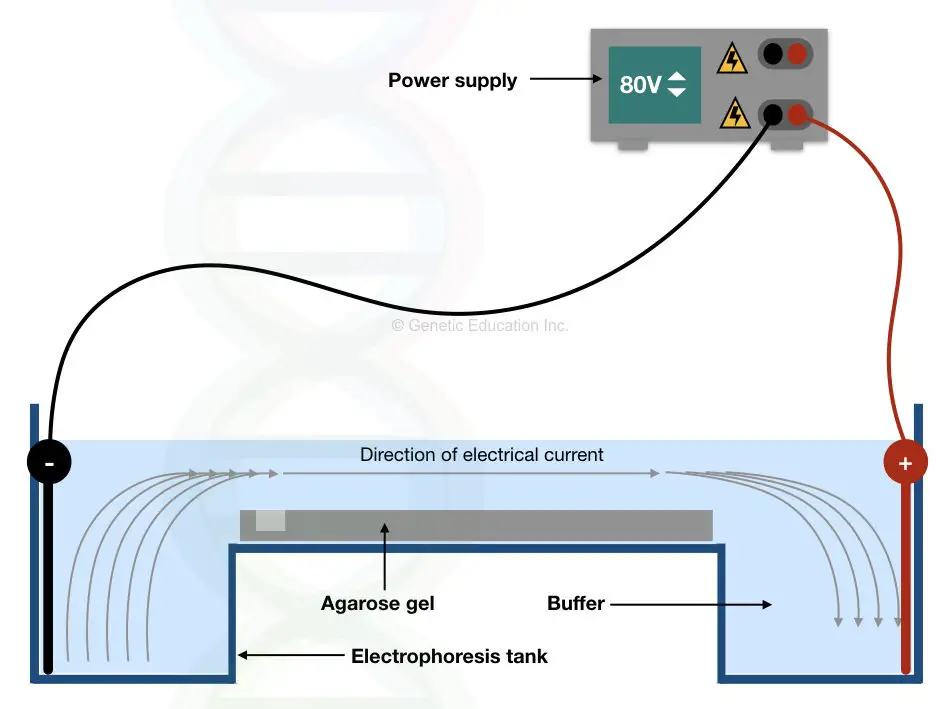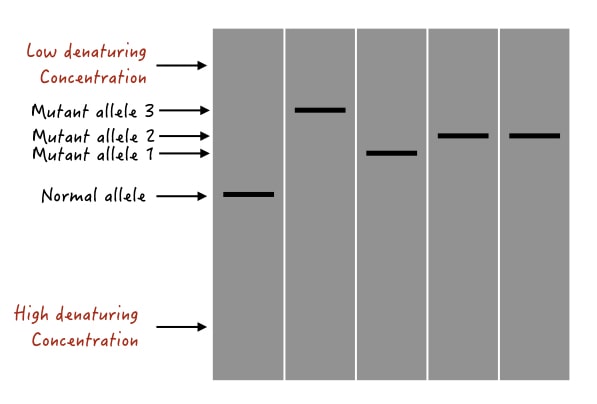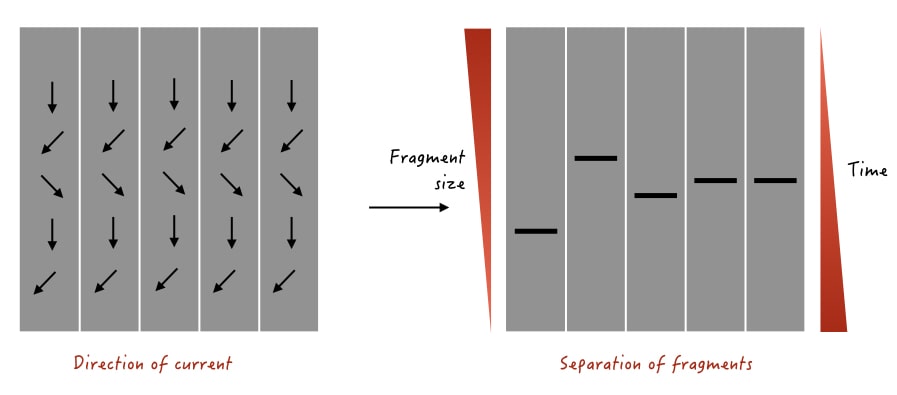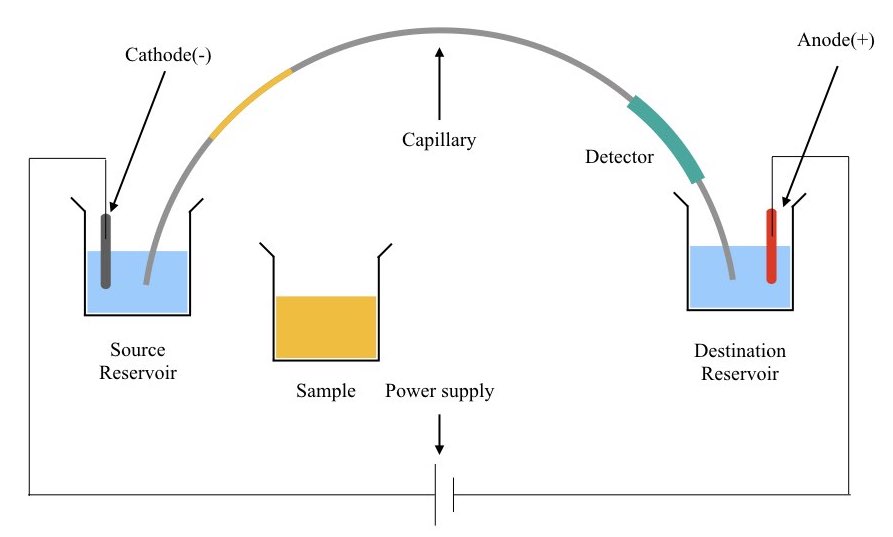“Learn about various types of DNA and RNA gel electrophoresis- Agarose, PAGE, PFGE, DGGE and Capillary electrophoresis, and their application in various fields of genetics.”
Electrophoresis is a technique to separate biomolecules based on their charge, shape and molecular mass. It is widely used in the study and separation of DNA, RNA and proteins. In a gel, charged molecules migrate from one to another side, depending the charge they carry.
Larger molecules run slower and smaller molecules run faster and farther in a gel. The gel matrix provides a medium for the migration of molecules. As our blog majorly discusses DNA and RNA topics, we will discuss gel electrophoresis in the context of molecular genetic studies only.
Gel electrophoresis, in molecular genetic studies used to check genomic DNA, run plasmid, bacterial or plant DNA, and validate PCR amplicons and restriction digestion results. However, depending on the requirement of the assay electrophoresis assay varies.
To study DNA or RNA, there are many electrophoresis techniques scientists are using, each having its own unique features and applications. At Genetic Education Inc. we re-research genetic knowledge and provide valuable, useful and understandable information.
In this article, I will explain different types of gel electrophoresis techniques used for DNA and RNA studies and other genetic research modules.
Stay tuned.
Related article: Common Issues in DNA/RNA Gel Electrophoresis and Troubleshooting.
Key Topics:
Different Types of DNA/RNA Gel Electrophoresis and Their Applications:
Agarose gel electrophoresis, Polyacrylamide gel electrophoresis, pulse-field gel electrophoresis, denaturing gradient gel electrophoresis and capillary electrophoresis are standard electrophoresis techniques used in DNA and RNA studies. Let us understand each method one by one.
Agarose gel electrophoresis:
Certainly, one of the most important, common and widely used techniques for DNA and RNA studies is agarose gel electrophoresis. The present technique is simple, effective and capable enough to distinguish different-sized DNA fragments. It is also utilized for the screening of genetic diseases too.
The polysaccharides of agarose create a porous gel matrix through which our DNA or RNA can migrate. When the sample is loaded and an electric current is applied, nucleic acid runs in the gel matrix. Smaller fragments run faster and farther while larger fragments run slower.
This property helps create differential banding patterns for DNA or RNA which can be studied using a known molecular marker DNA or RNA ladder.
EtBr fluorescence staining helps visualize DNA fragments under UV light. Note that extensive gel preparation is required. To learn more you can read our previous article: Agarose gel electrophoresis.

Applications
Agarose gel electrophoresis, as said above, is widely used in DNA and RNA studies, PCR analysis, genotyping, disease diagnosis, molecular cloning and genetic engineering studies. Furthermore, it’s also applicable in marker-assistant studies, DNA fingerprinting and genetic testing.
PAGE:
PAGE is polyacrylamide gel electrophoresis. It is a vertical type of electrophoresis used to separate DNA, RNA and proteins. Though it is popularly used in protein studies, it has impressive applications in genetic studies too, due to its higher resolution.
Here, instead of polysaccharide agarose, polyacrylamide is used which creates a porous structure in the gel. Nucleic acid can migrate through the pores vertically and separate. The present technique is so powerful that it can even differentiate single molecular change in the gel which agarose can’t do.
Due to this reason, scientists also prefer PAGE over native agarose gel electrophoresis for blotting and sequencing analysis.
Applications:
PAGE is widely used in the separation of DNA and RNA, blotting, and analysis of DNA sequencing results. Thus it’s also utilized in genotyping, analysis of disease-related alleles and DNA fingerprinting.
Interestingly, first-generation sequencing techniques like Sanger sequencing highly relied on PAGE-based analysis. Four different chain termination reactions are loaded on four different lanes and allow individual fragments to separate.
Denaturing Gradient Gel Electrophoresis:
DGGE- Denaturing Gradient Gel Electrophoresis is widely used in the separation of medium to larger-sized DNA or RNA fragments based on their melting or denaturing characteristic. Conventional agarose gel electrophoresis can separate DNA based on its size and charge.
Similar-sized fragments often have sequence differences, which can’t be determined by the agarose technique. Such fragments can be distinguished depending on their melting temperature. It’s the temperature at which dsDNA melts. So technically different domains of DNA have different melting temperatures even having the same fragment size.
Along with the gel, two additional elements– a denaturant (which denatures the DNA) and a temperature gradient is added to the gel electrophoresis. The setup here is almost similar to the PAGE which uses polyacrylamide gel and denaturants like urea or formamide.
As the fragment moves in the gel, the temperature and the concentration of denaturant gradually increase, hence, each fragment, when it reaches its melting temperature, will denature. The gel is stained to visualize the results under UV light.

Applications:
DGGE is a powerful technique that can even detect single base pair change, thus, it is often used for the detection of SNPs and other mutations, DNA fingerprinting, genotyping and microbial identification. It can also be utilized for mutation detection in cancer as well.
Related article: 7 Ways to Determine Genotypes Using Gel Electrophoresis.
Pulse-Field Gel Electrophoresis (PFGE):
PFGE- Pulse-Field Gel Electrophoresis is a separation optimization of the native electrophoresis. Ok, so how does it work and why do we need it? Conventional agarose gel can run DNA fragments up to 15Kb, effectively. Larger fragments co-migrate and can’t be distinguished.
To solve this problem, in 1982, Swartz introduced pulse-field gel electrophoresis to separate DNA molecules >15 or 20 Kb in size. When the direction and speed of the current are periodically changed, such clumped fragments are separated and migrate at different speeds.
In the end, every larger fragment will separate sharply in the gel. The conventional gel staining technique is sufficient enough to evaluate results.

Applications:
As it’s specifically designed only to separate larger DNA molecules, it’s used in genomic DNA studies, restriction digestion and separation of bacterial DNA.
Capillary Gel Electrophoresis (CGE):
Capillary Gel Electrophoresis is the most advanced, robust, state-of-art and high throughput version of electrophoresis. The entire system is almost automatic and only requires loading the sample.
Instead of a gel plate, smaller capillaries filled with the gel solution are used to separate the DNA. However, the principle of separation is almost similar to conventional gel electrophoresis. The technique is speedy, less laborious and gives us the strength to investigate single base change, effectively.
I have written an amazing article on this topic in which I have explained the principle, process and advantages of the capillary electrophoresis technique. Click the link to read it.

Applications:
Capillary electrophoresis is one of the most important techniques in recent times which is used to study sequence-level alterations, DNA sequencing, DNA fingerprinting, DNA testing, allelic discrimination studies, mutations studies and investigating novel genetic variants.
COMET assay electrophoresis:
Comet electrophoresis is a single-cell electrophoresis technique used for the detection of DNA damage from a cell. The principle of comet assay is simply similar to conventional electrophoresis with a slight modification.
When DNA-damaged cells are run in a low melting gel, it creates a comet-like DNA-shearing structure in a gel, unlike normal and undamaged cells. The separation is also depending on its electrical charge and molecular weight. The amount of DNA damage can be investigated by this means for a cell.
Applications:
It is used in DNA damage and repair studies, genotoxicity, biomolecular monitoring, apoptosis and sperm DNA fragmentation studies.
Related article: The Comet Assay to Detect DNA Damage.
Summary:
| Gel electrophoresis type | Resolution | Applications |
| Agarose gel electrophoresis | 100bp to 25Kb | Genomic DNA, PCR and restriction digestion studies. |
| PAGE | 1bp | DNA sequencing, genotyping and mutational studies. |
| Density gradient gel electrophoresis | 100bp to 25Kb | Allelic variation and genotyping. |
| Pulse-field gel electrophoresis | >15Kb | Bacterial DNA and genomic DNA digestion studies. |
| Capillary gel electrophoresis | 1bp | High-resolution DNA sequencing. |
Wrapping up:
In conclusion, gel electrophoresis is a crucial and versatile genetic technique that can routinely be used in the separation of DNA. However, the choice of technique depends on the requirement of the assay.
Each technique has its own advantages and limitations and is chosen based on that only. For example, to study sequence level variation, we need PAGE or CE, not agarose gel. Notwithstanding, agarose gel electrophoresis is one of the commonest techniques used in every genetic lab.
I hope you like this article and learn meaningfully. I have written articles on a few techniques discussed here and plan to write more on other techniques too. Till then, do subscribe to our blog, allow notifications and bookmark the page.



